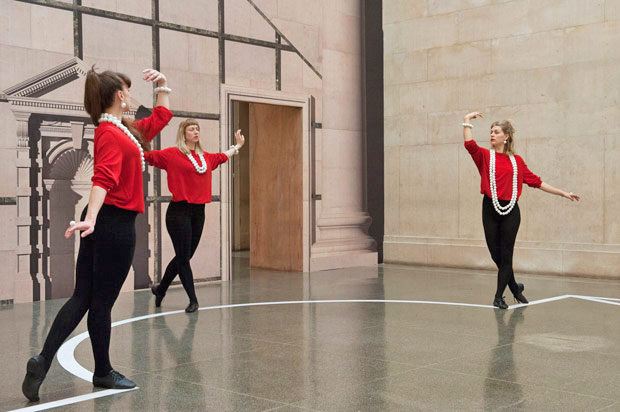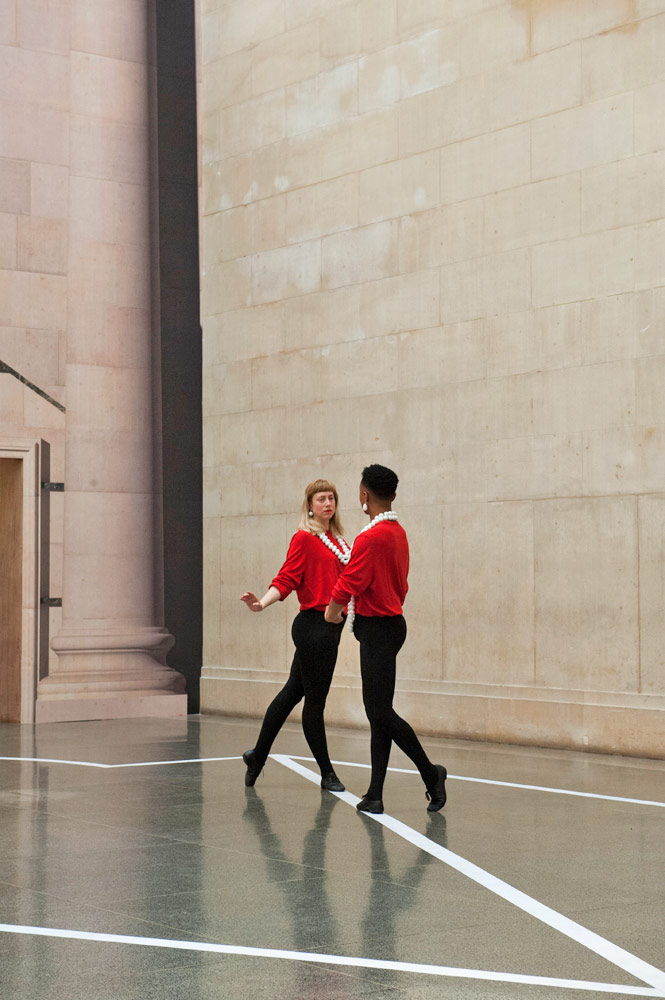
Image: BrothertonLock, © Pablo Bronstein. (Click image for larger version)
Pablo Bronstein: Historical Dances in an Antique Setting
London, Tate Britain, Duveen Galleries
Showing: 26 April – 9 October 2016
Press viewing: 25 April 2016
www.tate.org.uk
For the next six months, dancers (three at a time) will be performing daily at Tate Britain from 11am to 5pm. Pablo Bronstein has installed them in the neo-classical Duveen sculpture galleries, once occupied in 2008 by Martin Creed’s runners sprinting through the empty halls.

Image: BrothertonLock, © Pablo Bronstein. (Click image for larger version)
Three dancers make their way in 15-minute sessions from the north gallery to the south, pausing in the Sackler Octagon space in the centre for a two-minute solo to baroque music (La Alta, from the album Cancionero, music for the Spanish court 1470-1520, recorded by the Dufay Collective). They will repeat their large-scale passage all day, with a fourth dancer ready to replace whoever is due for a rest period.
There will be 12 dancers in all, drawn from a network of independent, classically trained dancers with whom Bronstein enjoys working. At the press view, the performers were Rosalie Wahlfrid, Margarita Zafrilla Olayo, Emilia Gasiorek and Luke Crook. The choreography was devised in workshops with Bronstein, drawing on baroque dance gestures and positions, ballet, contemporary dance and voguing posturing. Only ironically could these be called ‘Historical Dances in an Antique Setting’: they are Bronstein’s irreverent comment on how the present perceives the past, how vainglorious are society’s pretensions.

Image: BrothertonLock, © Pablo Bronstein. (Click image for larger version)
He speaks of ‘historical compression’ in the dance styles and the outfits the performers wear. Balletic tights or leggings are overlaid with baggy red sweatshirts hung with ropes of pearls; yet more oversize pearls decorate the ears, wrists and fingers of the dancers. They have been asked to display the virtues of sprezzatura, the assumed nonchalance recommended in ‘The Book of the Courtier’ (1528) by Baldassare Castiglione. Italian Renaissance courtiers, skilled in swordplay, music and dancing, were advised to conceal effort with calm faces and graceful gestures (much like ballet training).
So Bronstein’s dancers pose serenely, feet turned out and wrists tilted or curlicued, fingers fluttering. In the south gallery, they are proud and rather camp, voguing two against one or in unison as a trio. In the north gallery, with its geometric floor patterns, they are more pedestrian, tracing the white lines as if improvising before co-ordinating their formal poses. Without music, they cue each other by glances or breath. Bronstein is an admirer of Rosemary Butcher’s choreography in art galleries and of Bruce Nauman’s eccentric performance pieces. But the shapes the dancers make also refer to the marble and plaster statuary once on display in the Duveen Galleries. Only in each solo in the centre of the space can they, briefly and calmly, be uniquely themselves.

Image: BrothertonLock, © Pablo Bronstein. (Click image for larger version)
Bronstein has collaborated with dancers in performance installations in Tate Modern and the Institute of Contemporary Arts, and elsewhere. His next involvement with dance will be designing Rambert’s performance of Haydn’s The Creation, with the singers and orchestra of Garsington Opera at Wormsley from 14-17 July this year.

















You must be logged in to post a comment.